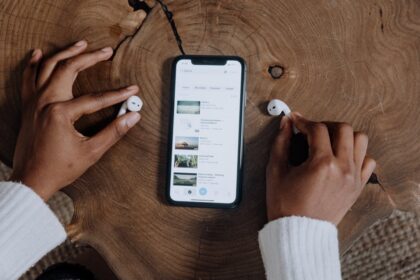Instagram advertising transcends mere visibility; it is an intricate art and science dedicated to visual persuasion. In a feed saturated with ephemeral content, only the most compelling visual strategies convert scrollers into customers. Success hinges on a profound understanding of Instagram’s unique ecosystem, one dominated by aesthetic appeal, mobile-first consumption, and instantaneous emotional connection. Advertisers must move beyond generic stock imagery, embracing a strategic approach where every pixel contributes to a meticulously crafted narrative designed for conversion. This involves not only understanding the technical specifications of various ad formats but also delving into the psychology of visual influence, the nuances of brand storytelling, and the iterative process of optimization through data.
The foundation of any high-converting Instagram visual strategy lies in recognizing the platform’s mobile-first imperative. Over 90% of Instagram users access the platform via mobile devices. This translates into a critical need for visuals optimized for small screens, fast load times, and thumb-stopping power. Images and videos must be crystal clear, high-resolution, and legible even when viewed quickly. Text overlays, if used, should be concise and large enough to read easily. Composition must consider the vertical orientation dominant in Stories and Reels, ensuring key elements are centered and visible without awkward cropping. Designers and marketers must prototype and test their creatives on actual mobile devices, ensuring the intended impact translates from concept to consumer screen. This foundational understanding dictates every subsequent decision in visual asset creation.
Deconstructing Instagram’s Core Ad Formats for Visual Conversion
Each Instagram ad format offers distinct visual opportunities and challenges, requiring tailored creative approaches to maximize conversion potential. Understanding these nuances is paramount.
1. Image Ads: The Power of a Single Frame
While seemingly simple, a single image ad on Instagram demands extreme precision. Its strength lies in its ability to immediately convey a message or evoke an emotion.
- Composition and Focus: The primary subject should be clear, well-lit, and immediately identifiable. Use the rule of thirds or leading lines to guide the viewer’s eye. Negative space can highlight the product.
- High-Quality Resolution: Blurry or pixelated images are instant conversion killers. Invest in professional photography or high-fidelity digital rendering.
- Authenticity vs. Aspiration: Strike a balance. Lifestyle shots that show the product in use, rather than isolated product shots, often perform better, making the product relatable and desirable. If selling a service, use compelling imagery that represents the benefit or outcome.
- Color Psychology: Colors evoke specific emotions. Warm colors (red, orange, yellow) can suggest energy or urgency, while cool colors (blue, green) can convey calm or trustworthiness. Align color palettes with brand identity and campaign goals.
- Text Overlay Strategy: Minimalistic text overlays can reinforce the message or highlight a unique selling proposition (USP). Ensure text is legible against the background, uses brand-consistent fonts, and adheres to Instagram’s 20% text rule (though less strictly enforced now, it remains a good guideline for readability).
- Call to Action (CTA) Visual Cues: While the CTA button is distinct, visual elements within the image can subtly direct attention towards it. For instance, a person in the image looking towards the CTA button, or a graphic element pointing subtly.
2. Video Ads: Dynamic Storytelling and Immersion
Video is Instagram’s most engaging format, capable of conveying complex narratives and demonstrating product utility.
- Hook in the First 3 Seconds: With short attention spans, the initial moments are critical. Use dynamic visuals, intriguing questions, or a strong problem statement to capture immediate attention.
- Sound Optional, Visuals Essential: Many users view videos without sound. Subtitles, on-screen text, and strong visual storytelling are non-negotiable. However, compelling sound design and music, when present, can significantly enhance emotional impact.
- Storytelling Arc: Even short videos benefit from a mini-narrative: problem, solution (your product/service), and desired outcome. Showcase benefits over features.
- Optimal Length and Aspect Ratio: While Instagram allows longer videos, shorter, punchy videos (15-60 seconds for feed, 15 seconds for Stories) often perform best for conversion. Experiment with 9:16 vertical for Stories and Reels, and 1:1 square or 4:5 vertical for feed.
- Motion Graphics and Animation: For abstract concepts or digital products, animated explainer videos or motion graphics can be highly effective in simplifying complex information.
- Demonstrations and Tutorials: Product demonstrations or mini-tutorials visually clarify how a product works, building trust and reducing purchase friction.
- Authenticity and Rawness: Highly polished, corporate videos can sometimes feel out of place. Experiment with more authentic, user-generated-style content, particularly for direct-to-consumer brands.
3. Carousel Ads: Sequential Storytelling and Product Showcasing
Carousel ads allow advertisers to tell a more comprehensive story across multiple images or videos.
- Narrative Flow: Each card should progress the story. This could be a before-and-after sequence, multiple product features, different color variations, or steps in a process.
- Varied Angles and Contexts: Showcase products from different angles, in different environments, or being used by different people.
- Problem/Solution Structure: The first card introduces a problem, subsequent cards offer solutions or demonstrate how your product solves it.
- Educational Content: Break down complex information into easily digestible chunks across multiple slides.
- User-Generated Content (UGC) Integration: Mix official brand content with authentic customer testimonials or product usage shots.
- Interactive Element: Encourage swiping by using visual cues like arrows or partial images that hint at more content beyond the first slide.
4. Collection Ads: Immersive Shopping Experience
Collection ads are designed for direct response, offering an immersive, full-screen experience that acts as a mini-catalog within Instagram.
- Hero Image/Video: The prominent visual should be captivating and representative of the collection. It sets the tone for the shopping experience.
- Product Selection: Choose accompanying products that are visually appealing and complement the hero media. Ensure high-quality product photography.
- Curated Product Sets: Group products logically (e.g., by category, outfit, style) to facilitate browsing.
- Clear Pricing and Availability: While not strictly visual, ensuring the information on the linked Instant Experience is clear is crucial for conversion.
- Speed and Responsiveness: The Instant Experience must load quickly and be fully optimized for mobile to prevent abandonment.
5. Reels Ads: Short-Form, Trend-Driven Verticals
Reels ads leverage the highly engaging, discoverable nature of Instagram’s short-form video content.
- Native Feel: Reels ads should blend seamlessly with organic Reels content. This means adopting popular trends, using trending audio (where copyright allows for commercial use), and maintaining a high-energy, fast-paced rhythm.
- Vertical Optimization (9:16): Absolutely critical. Design for full-screen vertical viewing.
- Music and Audio Integration: Sound is paramount in Reels. Use trending audio intelligently to capture attention, ensuring it aligns with brand messaging and visual content. Voiceovers can be highly effective.
- Quick Transitions and Edits: Fast cuts keep viewers engaged. Experiment with popular transition styles seen in organic Reels.
- Behind-the-Scenes or Authentic Content: Reels are often driven by authenticity. Show imperfect, raw, or “day in the life” style content.
- Educational Bites or Quick Tips: Deliver valuable, concise information in an entertaining format.
- Call to Action: Integrate your CTA clearly, either through on-screen text, voiceover, or a prominent button at the end.
6. Stories Ads: Immediacy, Interactivity, and Full-Screen Domination
Stories ads offer a unique opportunity for full-screen, immersive visual engagement.
- Vertical Dominance (9:16): Fill the entire screen. No black bars.
- Immediacy and Ephemerality: Leverage the feeling of “now.” Use urgency (e.g., limited-time offers).
- Interactive Elements: Use polls, quizzes, or question stickers (even if only implied for ad purposes) to encourage engagement and gather insights. Swipe-up links are crucial for conversion.
- Behind-the-Scenes and Authenticity: Stories are often where brands show their more human, unfiltered side. Use raw footage, unedited testimonials, or glimpses into your creative process.
- Call to Action Clarity: Make the swipe-up clear and intuitive. Use visual cues like arrows or text prompts.
- Speed and Pacing: Keep it short and to the point. Most Stories are 15 seconds. Deliver your message quickly.
- Brand Consistency: While raw, ensure your brand’s visual identity (colors, fonts, tone) is still present.
7. Explore Ads: Discovery-Oriented Visuals
Explore ads appear within the Explore tab, where users discover new content and accounts.
- Discovery Mindset: Users here are actively looking for new things. Visuals should be intriguing, high-quality, and align with broader interests.
- Broad Appeal: Visuals in Explore should resonate with a wider audience as targeting here is less precise than other placements.
- Native Integration: Blend seamlessly with the surrounding organic content. Avoid overly aggressive sales pitches visually.
- Category Relevance: If targeting specific interest categories within Explore, ensure your visuals are highly relevant to that niche.
Core Visual Strategy Principles for Conversion
Beyond individual ad formats, overarching visual principles dictate whether your Instagram ads convert.
1. Clarity, Simplicity, and Visual Hierarchy
Clutter is the enemy of conversion. A busy visual overwhelms the viewer, diffusing the message and diluting the CTA.
- One Primary Message: Focus on a single, clear message or call to action per visual.
- Minimalism: Use whitespace effectively. Reduce unnecessary elements.
- Visual Hierarchy: Guide the viewer’s eye to the most important elements (product, benefit, CTA) using size, color contrast, and placement.
- Legibility: Ensure all text, including product names and prices, is easily readable on small screens.
2. Emotional Connection and Aspiration
People buy emotions and solutions, not just products.
- Show, Don’t Just Tell: Instead of describing “comfort,” show someone looking blissful while using your product.
- Evoke Desire: Use visuals that create a sense of longing, aspiration, or problem-solving.
- Authenticity: Real people, real emotions. Avoid overly staged or artificial visuals that feel disingenuous.
- Relatability: Showcase diverse models and scenarios that resonate with your target audience.
- Before & After: Visually demonstrate transformation or improvement. This is highly effective for beauty, fitness, and home improvement products.
3. Brand Consistency and Recognition
A strong visual identity fosters trust and recall, making future conversions easier.
- Consistent Color Palette: Use brand-specific colors consistently across all ad creatives.
- Brand Fonts: Maintain a consistent typography that aligns with your brand’s personality.
- Logo Placement: Subtle, consistent logo placement reinforces brand recognition without being intrusive.
- Visual Motifs: Recurring visual elements (e.g., a specific filter, framing style, or recurring character) can help instantly identify your brand.
- Tone and Style: Is your brand playful, luxurious, minimalist, or rustic? Your visuals should reflect this consistently.
4. User-Generated Content (UGC): The Power of Social Proof
UGC is inherently authentic and acts as powerful social proof, often outperforming professional content for conversion.
- Authenticity Sells: Real people using your product is far more convincing than models in a studio.
- Trust and Relatability: UGC builds trust because it comes from real customers, not the brand directly.
- Diverse Perspectives: UGC showcases your product in various contexts and by different people, broadening its appeal.
- Leverage for Retargeting: Use UGC from existing customers to convert warm leads.
- Permission is Key: Always obtain explicit permission before using customer content in ads. Credit the creator.
5. Influencer Collaborations: Amplifying Visual Reach and Trust
Collaborating with influencers offers access to pre-established audiences and leverages their unique visual aesthetic.
- Aesthetic Alignment: Choose influencers whose visual style and brand perfectly align with yours. Mismatch can lead to dissonance.
- Authentic Integration: Encourage influencers to integrate your product naturally into their content rather than producing overly promotional, staged visuals.
- Storytelling through the Influencer’s Lens: Allow the influencer to tell your brand’s story in their authentic voice and visual style.
- Diverse Influencer Types: Micro-influencers often deliver higher engagement and trust within niche communities. Macro-influencers offer broader reach.
- Track Performance: Monitor conversion rates from influencer-generated content to identify the most effective partnerships.
6. Storytelling Through Visuals: Crafting a Narrative
Visual storytelling builds a deeper connection than isolated images.
- Problem-Solution Arc: Show a pain point, then demonstrate how your product alleviates it.
- Journey/Transformation: Illustrate a user’s journey from their initial state to their improved state with your product.
- Aspiration: Paint a picture of the ideal lifestyle or outcome associated with your brand.
- Human Element: Feature people experiencing the benefits of your product.
- Behind-the-Scenes: Show the effort, craftsmanship, or passion behind your brand.
7. Call-to-Action (CTA) Integration: Guiding the User
The CTA is the ultimate conversion point. Visuals must support and clarify it.
- Visual Prominence: While the CTA button is Instagram’s feature, the ad visual should subtly draw attention to it.
- Clear Messaging: Ensure any on-screen text or voiceover reinforces the CTA (e.g., “Shop Now,” “Learn More,” “Sign Up”).
- Urgency/Scarcity: If applicable, visually represent limited stock or a ticking clock to encourage immediate action.
- Consistent Placement: If using multiple ad types, try to maintain a consistent visual flow towards where the CTA typically appears.
Advanced Visual Optimization Techniques for Enhanced Conversion
To move beyond good to great, advertisers must employ sophisticated techniques.
1. A/B Testing Visuals: Iterative Improvement
A/B testing is non-negotiable for understanding what resonates with your audience and drives conversion.
- Isolate Variables: Test one visual element at a time (e.g., background color, model vs. product only, different headlines, video length, first frame of video).
- Clear Hypotheses: Before testing, hypothesize why one visual might outperform another (e.g., “we believe lifestyle imagery will convert better than product-only shots because it evokes more emotion”).
- Sufficient Sample Size: Ensure enough budget and time for each variation to gather statistically significant data.
- Meaningful Metrics: Focus on conversion metrics (CPA, ROAS) rather than just vanity metrics like likes or comments.
- Continuous Iteration: A/B testing is not a one-time event but an ongoing process. Learn from each test and apply insights to future creatives.
- Test Dynamic Elements: Experiment with different call-to-action button colors or text if the platform allows customization.
2. Dynamic Creative Optimization (DCO): Personalizing Visuals at Scale
DCO allows advertisers to automatically generate multiple visual variations and serve the most relevant one to each individual user based on their predicted preferences and past interactions.
- Asset-Based Approach: Upload a library of images, videos, headlines, descriptions, and CTAs.
- Algorithm-Driven Personalization: Facebook/Instagram’s algorithms combine these assets in real-time to create ads tailored to specific audience segments.
- Improved Relevance: Leads to higher engagement and conversion rates by showing users the most appealing visual combination.
- Reduced Manual Effort: Automates the testing and optimization process that would be cumbersome manually.
- Requires Robust Data: DCO is most effective when fueled by rich audience data (e.g., CRM lists, website pixel data).
- Visual Storytelling at Scale: Allows for nuanced visual narratives to be presented to different audience segments.
3. Mobile-First Design Imperative: Beyond Just Resizing
Designing for mobile isn’t just about scaling down desktop visuals; it’s a fundamental shift in approach.
- Thumb-Stopping Power: Visuals must grab attention instantly on a fast-scrolling feed. Bold colors, strong focal points, and dynamic motion are key.
- Vertical Orientation: Embrace 9:16 aspect ratio for Stories and Reels. For feed, 4:5 vertical images often outperform square or horizontal.
- Finger-Friendly CTAs: Ensure buttons within Instant Experiences or Collection Ads are large enough and clearly spaced for easy tapping.
- Readability: Text should be large, high-contrast, and concise. Avoid small fonts or busy backgrounds that make reading difficult.
- File Size Optimization: Optimize image and video file sizes to ensure fast loading times, crucial for retaining mobile users.
- Responsive Design: If driving traffic to a landing page, ensure the landing page itself is fully responsive and loads quickly on mobile.
4. Accessibility in Visuals: Inclusivity for Wider Reach
Designing for accessibility not only broadens your audience but also often leads to clearer, more effective visuals for everyone.
- High Contrast: Ensure sufficient contrast between text and background colors for readability.
- Alt Text for Images: Though primarily for screen readers, well-written alt text for ad images can also improve SEO and ad relevance.
- Descriptive Video Captions: Include accurate captions for videos, especially for those viewing without sound or with hearing impairments.
- Avoid Flashing/Stroboscopic Effects: Such effects can trigger seizures in susceptible individuals.
- Inclusive Imagery: Represent a diverse range of people in your visuals (different ages, ethnicities, body types, abilities) to appeal to a broader audience.
5. The Role of Copy in Visual Conversion: A Symbiotic Relationship
While this article focuses on visuals, it’s crucial to acknowledge that copy and visuals are two sides of the same conversion coin. They must work in harmony.
- Visuals Grab Attention, Copy Converts: The visual hooks the user, but the headline and primary text provide context, clarify benefits, and drive the final action.
- Concise and Impactful Headlines: Your headline should complement the visual, adding immediate value or intrigue.
- Benefit-Oriented Copy: Explain how the product shown in the visual solves a problem or improves the user’s life.
- Clear Call to Action: Reinforce the visual CTA with explicit instructions in the ad copy.
- Storytelling Consistency: Ensure the narrative presented visually is continued and elaborated upon in the accompanying text.
- Microcopy: Use short, impactful phrases that accompany visual elements, like product tags or price overlays.
Targeting and Audience Insights for Visual Relevance
Even the most stunning visuals will fail if they aren’t seen by the right audience. Targeting ensures visual relevance.
1. Audience Demographics and Psychographics: Tailoring the Aesthetic
Understanding who your audience is allows you to craft visuals that resonate deeply.
- Age and Generation: Visual preferences vary significantly. Gen Z prefers authentic, raw, and trend-driven visuals (Reels-style), while older demographics might prefer more polished, aspirational imagery.
- Gender: Certain visual themes or product presentations might appeal more to specific genders.
- Interests and Hobbies: Tailor visuals to align with specific interests. If targeting fitness enthusiasts, show active people. If targeting luxury consumers, use high-end aesthetics.
- Behaviors and Lifestyles: Consider their daily routines, values, and aspirations. Does your visual reflect their desired lifestyle?
- Location-Specific Visuals: If targeting geographically, use imagery that reflects local landmarks, cultural nuances, or relevant seasonal themes.
- Psychological Triggers: Research common psychological triggers for your target market (e.g., desire for belonging, status, security, convenience) and create visuals that activate these.
2. Lookalike Audiences: Expanding Reach with Visual Consistency
Lookalike audiences are powerful for finding new prospects who share characteristics with your existing customers.
- Visual Homogeneity: While the audience is new, their behavioral patterns are similar. This often means visual styles that worked for your core audience will also resonate with lookalikes.
- Seed Audience Quality: The better your seed audience (e.g., high-value customers, website visitors who converted), the more precise the lookalike, allowing for more targeted visual strategies.
- Testing Different Lookalike Percentages: Experiment with different lookalike percentages (e.g., 1% vs. 5%) as this can impact the breadth of the audience and potentially require slightly adjusted visuals.
3. Retargeting: Hyper-Relevant Visuals for Warm Leads
Retargeting allows you to re-engage users who have previously interacted with your brand. This segment is primed for conversion.
- Product-Specific Visuals: If a user viewed a specific product on your website, show them ads featuring that exact product, perhaps with a slight discount or reminder of its benefits.
- Abandoned Cart Visuals: Use compelling visuals of the items left in their cart, reminding them of the value or offering a small incentive.
- Cross-Sell/Upsell Visuals: For existing customers, show visuals of complementary products or premium versions of what they’ve already purchased.
- Testimonial/UGC Retargeting: Use visuals featuring satisfied customers to build trust with those on the fence.
- Demonstration Visuals: For complex products, retarget with video demonstrations that address potential objections.
4. Placement Optimization: Visuals Across the Ecosystem
Instagram’s ad placements (feed, Stories, Reels, Explore, Audience Network) require distinct visual considerations.
- Native Look and Feel: Ensure your visuals blend seamlessly with the organic content of each placement. Stories and Reels demand raw, vertical video; feed posts benefit from high-quality photography.
- Aspect Ratio Adaptability: Design visual assets that can be easily cropped or adapted for various aspect ratios without losing critical information or aesthetic appeal.
- Dynamic Placement Testing: Allow Instagram’s platform to dynamically place your ads across different placements and analyze which ones drive the best visual engagement and conversions.
- Creative Asset Customization per Placement: Increasingly, advertisers are creating entirely different sets of visuals for each placement to maximize native appeal and performance.
Measuring Visual Ad Performance and Conversion
Visual strategies are only effective if their impact can be measured and optimized.
1. Key Metrics Beyond Impressions and Reach:
While impressions and reach are important for awareness, conversion-focused visual strategies demand deeper metrics.
- Click-Through Rate (CTR): A high CTR indicates that your visuals are compelling enough to stop the scroll and encourage a click. This is a primary indicator of visual effectiveness.
- Conversion Rate (CVR): The percentage of clicks that result in a desired action (purchase, lead, download). This is the ultimate measure of visual strategy success for conversion.
- Cost Per Acquisition (CPA): The cost to acquire a single customer or lead. Lower CPA indicates more efficient visual spend.
- Return on Ad Spend (ROAS): The revenue generated for every dollar spent on ads. A strong ROAS validates your visual investment.
- Engagement Metrics (Saves, Shares): While not direct conversion metrics, high saves and shares suggest your visuals are highly valuable, shareable, and resonating deeply with the audience.
- Video View Metrics: For video ads, completion rate, average watch time, and 3-second view count indicate how engaging your video visuals are.
2. Facebook Ads Manager Insights: Diving Deep into Creative Breakdown
The Ads Manager is your primary tool for analyzing visual performance.
- Breakdown by Creative: Analyze performance (CTR, CVR, CPA) for each individual ad creative. Identify your top-performing visuals.
- Creative Reporting: Utilize built-in reports to compare different visual variations and their impact on key metrics.
- Heatmaps and Click Tracking (via third-party tools/landing pages): While not directly in Ads Manager, using tools that show where users click on your landing page after seeing your ad can offer insights into what visual elements on your landing page are converting.
- Audience Breakdown by Creative: See how different visual creatives perform across various audience segments. This can reveal that certain visuals resonate more with specific demographics or interests.
3. Attribution Models: Understanding the Visual Journey
Modern customer journeys are rarely linear. Attribution models help understand the visual touchpoints.
- Last-Click Attribution: Often the default, it credits the last visual ad clicked before conversion. Simple, but might underrepresent earlier visual exposure.
- Multi-Touch Attribution (e.g., Linear, Time Decay, U-Shaped): These models distribute credit across multiple visual touchpoints in the customer journey, providing a more holistic view of how different visual ads contribute to a conversion.
- Custom Attribution Models: For advanced advertisers, defining custom models based on your specific funnel and visual interaction points can provide highly accurate insights.
- Pixel Data: Ensure your Facebook Pixel is correctly implemented and tracking all relevant conversion events, providing the data necessary for accurate attribution.
- Offline Conversions: For businesses with offline sales, integrating offline conversion data with Instagram ad insights can provide a complete picture of visual impact on sales.
Ethical Considerations and Best Practices in Visual Advertising
Maintaining trust and transparency is crucial for long-term conversion success.
1. Transparency and Disclosure:
- Clearly Mark Sponsored Content: Instagram automatically labels ads, but for influencer collaborations, ensure proper disclosure using #ad or #sponsored.
- Authenticity over Deception: Avoid misleading visuals, exaggerated claims, or heavily retouched images that misrepresent the product. Trust is paramount for conversion.
2. Data Privacy and User Trust:
- Respect User Data: While using targeting data for visual relevance, be mindful of privacy. Avoid collecting or using data in ways that could be perceived as intrusive.
- Ad Fatigue: Constantly showing the same visual to the same audience can lead to ad fatigue, which hurts performance and can annoy users. Rotate your creatives frequently.
3. Inclusivity and Representation:
- Diverse Representation: Ensure your visuals represent a broad spectrum of your potential audience, reflecting diversity in race, age, gender, body type, and ability.
- Avoid Stereotypes: Do not perpetuate harmful stereotypes through your visual choices.
- Cultural Sensitivity: Be aware of cultural nuances when creating visuals for different markets. What is appealing in one region might be offensive in another.
4. Brand Safety and Reputation:
- Appropriate Content: Ensure all visual content adheres to Instagram’s advertising policies, avoiding nudity, violence, hate speech, or illegal activities.
- Positive Brand Image: Your visuals are a direct reflection of your brand. Strive for high-quality, positive, and memorable imagery that enhances your reputation.
- User Feedback Monitoring: Pay attention to comments and direct messages on your ads. Negative feedback about visuals can indicate a need for revision.
Ultimately, Instagram advertising’s conversion power resides in its visual prowess. By meticulously crafting visuals for each ad format, adhering to core principles of clarity, emotion, and brand consistency, leveraging advanced optimization techniques like A/B testing and DCO, and maintaining a steadfast commitment to ethical practices, advertisers can transform casual scrolls into measurable, impactful conversions, forging lasting connections with their audience in a visually driven world. The journey is continuous, demanding constant innovation, data-driven refinement, and an unwavering focus on the visual narrative that inspires action.











